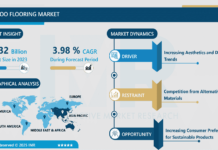Global Smart Lighting and IoT LED Market Poised for Significant Growth
The global smart lighting market is on a trajectory of substantial growth, with projections indicating a Compound Annual Growth Rate (CAGR) of 12.2% from 2022 to 2029, ultimately reaching an estimated value of $39.91 billion by 2029, according to Meticulous Research®. This expansion is driven by the rising demand for IoT-enabled lighting solutions, the growing focus on energy-efficient systems, and the rapid adoption of smart home technologies. Complementing this growth, the IoT LED Smart Lighting market is expected to increase from $63.68 billion in 2024 to $210.0 billion by 2032, with a CAGR of 16.09% during this period.
Key Growth Drivers
- Technological Advancements: The transition from traditional lighting to connected, IoT-enabled lighting systems is one of the primary factors fueling the market. IoT LED smart lighting systems offer enhanced control, energy efficiency, and automation, making them essential for modern smart homes and cities.
- Energy Efficienc: The global push towards sustainability and energy efficiency is propelling the adoption of smart lighting systems. These systems, particularly those incorporating LED technology, are designed to reduce energy consumption and extend the lifespan of lighting solutions, making them both environmentally friendly and cost-effective.
- Smart Cities and Smart Homes: The proliferation of smart city initiatives and the increasing penetration of smart home technologies are driving significant demand for advanced lighting systems. Smart lighting not only enhances convenience but also integrates with broader smart home ecosystems, providing users with seamless control via smartphones, tablets, or voice assistants.
Market Segmentation and Regional Dynamics
– Offering: The smart lighting market is segmented into hardware, software, and services. The hardware segment is currently dominant, driven by the growing demand for smart lights and intelligent street lighting. However, the software segment is expected to witness the highest growth, spurred by the need for applications that integrate with smart platforms like Alexa, Siri, and Google Assistant.
– Connectivity Mode: The market is categorized into wired, wireless, and hybrid connectivity modes. While wired solutions currently lead due to their reliability, hybrid systems combining wired and wireless technologies are forecasted to grow rapidly, offering both reliability and flexibility.
– Application: The market spans residential, commercial, and industrial applications, with the outdoor segment expected to register the highest CAGR due to government initiatives promoting energy efficiency and the adoption of smart lighting in public infrastructure.
– Regional Dynamics: Europe is anticipated to lead the global smart lighting market, driven by strong government support and widespread adoption of energy-efficient technologies. Asia-Pacific, however, is expected to experience the fastest growth, propelled by increasing investments in smart city projects and infrastructure development.
Industry Challenges and Opportunities
While the market is set for robust growth, certain challenges remain. High initial costs associated with smart lighting systems can deter adoption, especially in cost-sensitive regions. Moreover, concerns about data privacy and security related to connected devices are significant barriers. However, as companies continue to innovate and bring more affordable solutions to the market, these challenges are likely to diminish.
The market also presents numerous opportunities, particularly in the integration of smart lighting with other IoT devices, creating more connected and intelligent environments. Additionally, as sustainability becomes a priority for consumers and businesses alike, the demand for energy-efficient, smart lighting solutions is expected to surge.
There are companies which are at the forefront of innovation, continually expanding their product portfolios and enhancing their technological capabilities. Recent developments include the launch of new IoT-enabled products, strategic acquisitions, and the expansion of smart lighting solutions into new markets.
Conclusion
The global smart lighting and IoT LED markets are on a path of rapid expansion, driven by technological advancements, increasing consumer awareness, and the growing need for energy-efficient solutions. As smart cities and smart homes continue to proliferate, the demand for advanced lighting systems is expected to rise, offering significant opportunities for industry players.




























